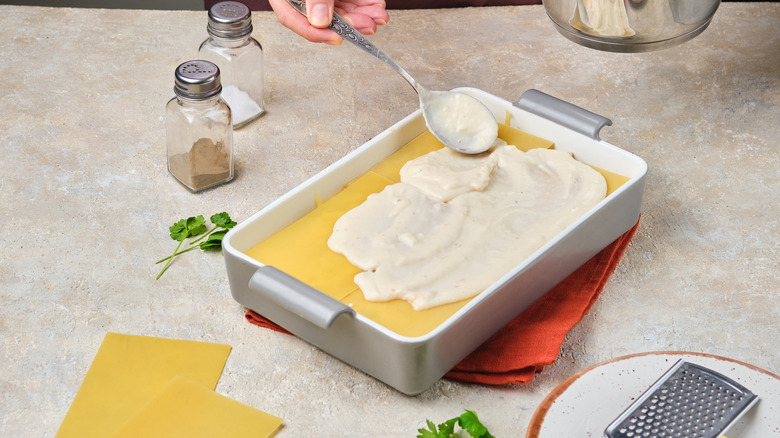The Genius Way Italians Layer Their Lasagna
Seeing as lasagna is among the most popular Italian dishes ever, it's not surprising that folks have vastly different methods of making it at home. While these differences in methodology can be a matter of how many layers your lasagna has, they can also be about how to assemble the dish in the first place. It turns out that while some people are less conscious of how to layer their lasagna, many Italians find that lacing the pasta in alternating directions gives it the structure it needs.
This strategy was relayed to us by Maricel Gentile, the chef and owner of Maricel's Kitchen, who expressed the importance of using pasta wisely so it can be a strong base for the loaded dish. "Think of it like building a woven basket," Gentile explained. "It helps everything hold together, especially when slicing. I find it makes cleaner cuts and fewer sloppy layers sliding out onto the plate." Furthermore, while the alternating layer strategy works for any kind of lasagna, Gentile added that taller versions of the dish particularly benefit from this vital step. "It's subtle, but it makes a difference," she assured.
How to layer lasagna to keep it intact
When it comes to layering pasta in alternating directions for lasagna, the strategy is quite simple. Arrange the first layer of lasagna noodles lengthwise and cover them with your lasagna fillings. Then, lay the following layer widthwise and repeat the process, alternating the direction of the noodles with each layer. "If the pasta sheet is too long, I trim it with kitchen shears or fold the excess under as it helps reinforce the edge, which is often the first place lasagna falls apart," Gentile advised.
Fortifying a lasagna can also be done with the help of your filling and how you distribute it. "Spread your ricotta or béchamel all the way to the edge of the pan. This helps seal the layers and avoid dry, crusty sides," Gentile added. As far as which filling to use, we recommend béchamel over ricotta for traditional Italian lasagna. Otherwise, Gentile notes that adding a small amount of shredded cheese to each layer will bring them all together in terms of both taste and consistency.
Another key step that people often forget about when making lasagna actually comes after the dish is already fully cooked. By letting your lasagna rest for 15 to 30 minutes after it's done in the oven, you prevent the lasagna's sauce from being watery — one of the biggest factors that affects your lasagna's strong structure.

